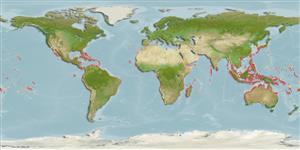Classification / Names
Common names from other countries
Main reference
Size / Weight / Age
Max length : 140 cm TL male/unsexed; (Ref. 40637); common length : 70.0 cm SL male/unsexed; (Ref. 9279); max. published weight: 4.8 kg (Ref. 40637)
Environment
Marine; brackish; reef-associated; oceanodromous (Ref. 51243); depth range 0 - 3 m (Ref. 58047)
Climate / Range
Subtropical, preferred 27°C (Ref. 107945); 38°N - 37°S, 180°W - 180°E
Distribution
Worldwide distribution in tropical and warm temperate waters. Eastern Atlantic: Cape Verde and Dakar to Moçamedes, Angola (Ref. 5757); ranging further south to Namibia (Ref. 12484). Western Atlantic: Chesapeake Bay (USA), Bermuda, and northern Gulf of Mexico to Brazil (Ref. 7251). Throughout the Indian Ocean. Western Pacific: off coasts and islands from southern Japan through the East Indies to Australia (Ref. 9682). Reported from Tuvalu (Ref. 12690). Eastern Pacific: Mexico to Peru. Entire Caribbean, Antilles and South American coast to Rio de Janeiro (Ref. 26938).
Countries | FAO areas | Ecosystems | Occurrences | Introductions
Short description
Dorsal
spines
(total): 0;
Dorsal
soft rays
(total): 23-26;
Anal
spines: 0;
Anal
soft rays: 24 - 28;
Vertebrae: 86 - 93. Dark bluish dorsally, silvery white ventrally with black blotches on middle of body (Ref. 5317). Body greatly compressed laterally; anterior parts of dorsal and anal fins with high falcate lobes. Pectoral fins falcate; about 12-14 prominent dark vertical bars on body; juveniles and adults have an elevated black lobe in the posterior part of the dorsal fin.
IUCN Red List Status (Ref. 115185)
Threat to humans
Harmless
Human uses
Fisheries: minor commercial; gamefish: yes
Tools
Special reports
Download XML
Internet sources
Estimates of some properties based on models
Phylogenetic diversity index
PD50 = 1.0000 many relatives (e.g. carps) 0.5 - 2.0 few relatives (e.g. lungfishes)
Trophic Level
4.5 ±0.80 se; Based on food items.
Resilience
Medium, minimum population doubling time 1.4 - 4.4 years (Assuming tmax>3; K=0.6)
Vulnerability
Moderate vulnerability (40 of 100)
Price category
